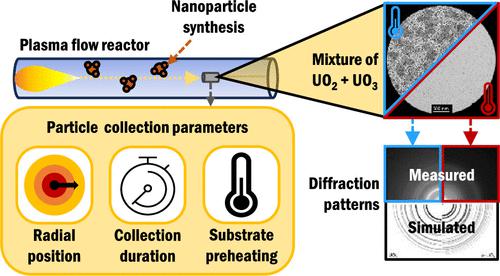当前位置:
X-MOL 学术
›
J. Phys. Chem. A
›
论文详情
Our official English website, www.x-mol.net, welcomes your feedback! (Note: you will need to create a separate account there.)
Dependence of Uranium Oxide Polymorphism on Plasma Synthesis Conditions
The Journal of Physical Chemistry A ( IF 2.9 ) Pub Date : 2024-03-14 , DOI: 10.1021/acs.jpca.3c08442 Emily N. Weerakkody 1 , Batikan Koroglu 1 , Zurong Dai 1 , Kate E. Rodriguez 1 , Enrica Balboni 1
The Journal of Physical Chemistry A ( IF 2.9 ) Pub Date : 2024-03-14 , DOI: 10.1021/acs.jpca.3c08442 Emily N. Weerakkody 1 , Batikan Koroglu 1 , Zurong Dai 1 , Kate E. Rodriguez 1 , Enrica Balboni 1
Affiliation

|
We synthesized uranium oxide nanoparticles using a plasma flow reactor (PFR) and studied the effects of three different experimental parameters on the resulting morphologies and speciation of the particles: (1) collection duration, (2) collection substrate temperature, and (3) radial collection position due to radial temperature gradients in the PFR. We also induced three distinct temperature histories along the axis of the plasma flow reactor by varying the gas flow rates downstream of the plasma torch. Transmission electron microscopy (TEM) analyses of collected particles showed two phases of uranium oxides (fcc-UO2 and α-UO3). The chemical compositions of the resulting uranium oxide particles were not altered by the three parameters investigated in this work but varied based on the temperature history induced. Preheating of the collection substrate led to deposition of fewer particles, which is attributed to a reduction in thermophoretic force caused by the reduced temperature gradient for preheated substrates. The relative amounts of UO2 to UO3 and particle size varied depending on the cooling history employed during synthesis.
中文翻译:

氧化铀多晶型对等离子体合成条件的依赖性
我们使用等离子流反应器 (PFR) 合成了氧化铀纳米颗粒,并研究了三种不同的实验参数对所得颗粒形态和形态的影响:(1) 收集持续时间,(2) 收集基底温度,以及 (3) 径向由于 PFR 中的径向温度梯度而导致的收集位置。我们还通过改变等离子炬下游的气体流速,沿等离子流反应器的轴线诱导了三个不同的温度历史。对收集的颗粒进行透射电子显微镜 (TEM) 分析显示出两相铀氧化物(fcc-UO 2和 α-UO 3)。所得氧化铀颗粒的化学成分并未因本工作中研究的三个参数而改变,而是根据引起的温度历史而变化。收集基底的预热导致沉积较少的颗粒,这是由于预热基底的温度梯度减小而导致热泳力的减小。 UO 2与UO 3的相对量和颗粒尺寸根据合成过程中采用的冷却历史而变化。
更新日期:2024-03-14
中文翻译:

氧化铀多晶型对等离子体合成条件的依赖性
我们使用等离子流反应器 (PFR) 合成了氧化铀纳米颗粒,并研究了三种不同的实验参数对所得颗粒形态和形态的影响:(1) 收集持续时间,(2) 收集基底温度,以及 (3) 径向由于 PFR 中的径向温度梯度而导致的收集位置。我们还通过改变等离子炬下游的气体流速,沿等离子流反应器的轴线诱导了三个不同的温度历史。对收集的颗粒进行透射电子显微镜 (TEM) 分析显示出两相铀氧化物(fcc-UO 2和 α-UO 3)。所得氧化铀颗粒的化学成分并未因本工作中研究的三个参数而改变,而是根据引起的温度历史而变化。收集基底的预热导致沉积较少的颗粒,这是由于预热基底的温度梯度减小而导致热泳力的减小。 UO 2与UO 3的相对量和颗粒尺寸根据合成过程中采用的冷却历史而变化。



























 京公网安备 11010802027423号
京公网安备 11010802027423号